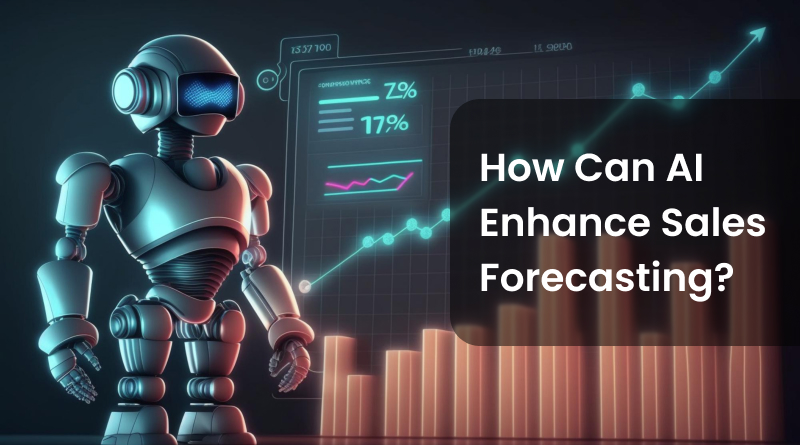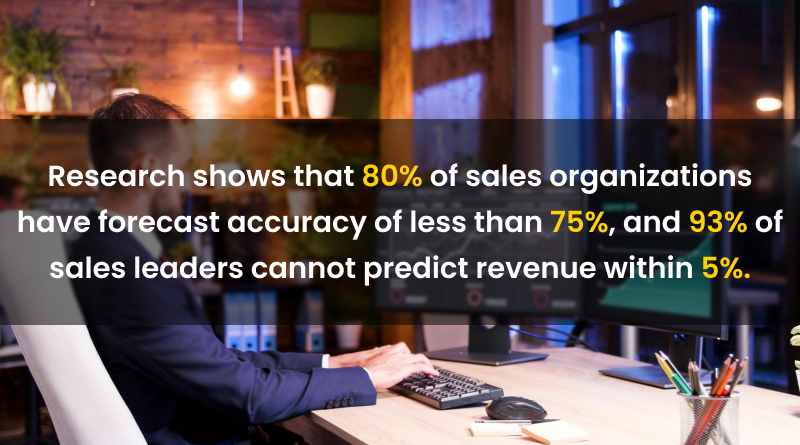How Can AI Enhance Sales Forecasting?
Sales forecasting can make a big difference to a business’s future revenue by helping it make better decisions. It actually holds the key to a company’s overall risk management, budgeting, and business planning. By using a corporation’s past sales data and current market trends, sales forecasting makes it easier to determine future sales performance.
Of course, that’s all we traditionally know about sales forecasting. But what about using artificial intelligence in sales?
As AI is making its way into the mainstream, more and more organizations are now interested in leveraging AI to unlock their full sales potential.
Table of contents
- The rise of AI in sales forecasting
- Challenges led by traditional methods of sales forecasting
- Does AI improve sales forecasting accuracy?
- Advantages of using AI in sales forecasting
- How to implement AI for sales forecasting?
- Real-world Applications of AI in Sales Forecasting
Did you know that a recent IBM study showed that 35% of companies reported using AI in their business and about 42% are exploring it? On the other hand, the Forbes Advisor Survey also found that companies are using AI in a wide range of areas, and sales forecasting is no exception. AI-powered sales forecasting can help businesses strategize and make better decisions with immediate impact.
This is especially true when we look at the accuracy rate of companies using traditional forecasting methods. Research shows that 80% of sales organizations have forecast accuracy of less than 75%, and 93% of sales leaders cannot predict revenue within 5%.
It seems surreal, doesn’t it? Let’s dive deeper into the uses of AI in Marketing and Sales with our full post below:
The Rise of AI in Sales Forecasting
In recent years, integrating artificial intelligence (AI) into various business operations has significantly improved efficiency, productivity, and decision-making. One area where AI is making a profound impact is in sales forecasting. Sales forecasting plays a crucial role in the success of any business. It involves predicting future sales performance based on historical data, market trends, and other relevant factors. Traditionally, sales forecasting relied heavily on manual analysis and subjective judgment, often leading to inaccuracies and inconsistencies.
AI algorithms are capable of analyzing vast amounts of data with speed and precision, allowing businesses to generate more accurate sales forecasts. By leveraging machine learning techniques, AI systems can identify patterns and trends in data that humans may overlook, leading to more informed and reliable predictions.
AI also offers advanced analytics capabilities that enable businesses to gain deeper insights into their sales performance. AI can help businesses identify new growth opportunities and optimize their sales strategies by analyzing customer behavior, purchasing patterns, and market trends.
This data-driven approach empowers businesses to make more informed decisions and achieve better results.
Challenges Led by Traditional Methods of Sales Forecasting
Sales forecasting is critical to business planning, providing insights into future sales trends and helping organizations make informed decisions. However, traditional sales forecasting methods often present challenges that hinder accuracy and reliability. Some of those challenges are as follows:
Reliance on Manual Processes
One of the primary challenges of traditional sales forecasting methods is the heavy reliance on manual processes. These processes involve gathering data from various sources, such as sales reports, historical data, and market research and manually analyzing this data to generate forecasts. This manual approach is time-consuming, labor-intensive, and prone to errors, leading to inaccuracies in sales predictions.
Limited Data Analysis
Traditional sales forecasting methods often rely on a limited scope of data analysis, focusing primarily on historical sales data and basic market trends. This narrow focus can result in overlooking important factors that impact sales performance, such as changes in consumer behavior, market dynamics, and competitive landscape. As a result, forecasts may fail to capture emerging trends or anticipate shifts in market demand, leading to inaccurate predictions.
Subjectivity and Bias
Another challenge of traditional sales forecasting methods is the inherent subjectivity and bias in decision-making. Human judgment plays a significant role in interpreting data, identifying patterns, and making forecasts, which can introduce bias and inconsistency into the forecasting process. Additionally, individual biases and preferences may influence decision-makers interpretations of data, leading to overestimation or underestimation of sales projections.
Inflexibility and Lack of Agility
Traditional sales forecasting methods are often characterized by inflexibility and a lack of agility in responding to changing market conditions. Once forecasts are generated, they are typically static and difficult to adjust in real time based on new information or developments. This rigidity can result in outdated forecasts that do not reflect current market dynamics, making it challenging for businesses to adapt their strategies and allocate resources effectively.
Does AI improve sales forecasting accuracy?
Accurate sales forecasting is paramount for effective decision-making and resource allocation in the fast-paced business world. As companies strive to stay ahead of the competition, many are turning to artificial intelligence (AI) to enhance the accuracy of their sales forecasts. But does AI truly improve sales forecasting accuracy?
The answer is a resounding yes. AI offers myriad benefits that can significantly enhance the accuracy of sales forecasts. One critical advantage of AI is its ability to process vast amounts of data quickly and precisely. AI algorithms can identify patterns and correlations that human analysts may overlook by analyzing historical sales data, market trends, customer behavior, and external factors such as economic indicators. This data-driven approach enables AI-powered forecasting models to generate more accurate predictions of future sales performance.
Furthermore, AI algorithms are capable of learning and adapting over time. AI models continuously improve their forecasting capabilities as they analyze more data and receive feedback on the accuracy of their predictions. This iterative learning process allows businesses to refine their sales forecasts and make more informed decisions based on real-time insights.
Moreover, AI enables businesses to incorporate more data sources into their forecasting models. AI-powered forecasting models can provide a more comprehensive view of market dynamics and customer behavior by integrating internal sales data with external data sources such as social media metrics, website analytics, and demographic data. This holistic approach enables businesses to anticipate changes in demand more accurately and adjust their sales strategies accordingly.
Advantages of using AI in sales forecasting
Integrating with CRM Systems
One significant advantage of Artificial Intelligence I in sales forecasting is its seamless integration with Customer Relationship Management (CRM) systems. AI-powered forecasting tools can directly interface with CRM platforms, allowing businesses to leverage their existing customer data effectively. By tapping into rich CRM datasets, AI algorithms can analyze customer interactions, purchase histories, and engagement patterns to identify trends and predict future sales opportunities.
Mitigating Risks
Another key advantage of AI in sales forecasting is its ability to mitigate risks associated with inaccurate predictions. Traditional forecasting methods rely on manual analysis and subjective judgment, leaving businesses vulnerable to forecasting errors and uncertainties. In contrast, AI-powered forecasting models leverage advanced data analytics and machine learning techniques to proactively identify potential risks and uncertainties.
Providing Real-Time Insights
AI-enabled sales forecasting tools offer real-time insights into sales performance and market trends, providing businesses with timely information to make informed decisions. By continuously analyzing incoming data streams and monitoring changes in customer behavior, AI algorithms can alert businesses to emerging trends, shifts in market demand, and potential sales opportunities in real time.
Customizing Forecasting
AI empowers businesses to customize their sales forecasting models to suit their needs and requirements. Unlike one-size-fits-all forecasting solutions, AI-powered tools can be tailored to accommodate specific industry dynamics, business objectives, and forecasting preferences. Businesses can customize forecasting models by adjusting variables, parameters, and algorithms to align with their sales processes and objectives.
Utilizing Predictive Analytics
AI leverages predictive analytics to forecast future sales performance with greater accuracy and reliability. Predictive analytics algorithms analyze historical sales data, customer behavior, and market trends to identify patterns and correlations that indicate future sales trends. By applying predictive modeling techniques, AI algorithms can generate forecasts that anticipate changes in customer demand, identify sales opportunities, and optimize inventory management.
Leveraging Data-Driven Insights
AI enables businesses to leverage data-driven insights to optimize their sales forecasting processes. By harnessing the power of advanced data analytics, AI algorithms can uncover valuable insights hidden within large datasets, enabling businesses to make informed decisions based on empirical evidence and statistical analysis. These data-driven insights enable businesses to identify key performance drivers, understand customer preferences, and optimize sales strategies to maximize profitability and growth.
How to implement AI for sales forecasting?
Assess business needs and objectives
The first step is to assess your organization’s specific needs and objectives regarding sales forecasting. Identify the key challenges and pain points in your current forecasting processes and the desired outcomes you want to achieve with AI implementation. Clarify the goals you want to accomplish, such as improving forecast accuracy, optimizing resource allocation, or identifying sales opportunities.
Select the Right AI Solution
Once you have defined your objectives, research and evaluate AI solutions tailored to sales forecasting. Consider factors such as the AI platform’s capabilities, compatibility with your existing systems and processes, scalability, and ease of integration. Choose a solution that aligns with your business requirements and offers the features and functionalities to address your specific challenges.
Gather and Prepare Data
Data is the foundation of AI-powered forecasting models. Gather relevant data sources, including historical sales data, customer information, market trends, and external factors that may influence sales performance. Cleanse, preprocess, and standardize the data to remove inconsistencies and errors. Additionally, identify any gaps or missing data that may impact the accuracy of the forecasting models.
Train AI Models
Train AI models using machine learning techniques to analyze historical sales data and generate forecasts. Utilize algorithms such as regression analysis, time series analysis, and neural networks to identify data patterns, correlations, and trends. Train the models on a diverse dataset to improve their accuracy and generalization capabilities. Continuously refine and optimize the models based on feedback and performance evaluation.
Integrate with Existing Systems
Integrate the AI-powered forecasting solution with your existing CRM, ERP, and other relevant systems to streamline data exchange and collaboration across departments. Ensure seamless integration and interoperability between systems to facilitate data flow and enable real-time updates. Customize the integration to meet your organization’s specific requirements and workflows.
Validate and Evaluate Performance
Validate the accuracy and reliability of the AI-generated forecasts through rigorous testing and validation processes. Compare the AI-generated forecasts with sales data to assess their accuracy, precision, and reliability. Conduct ongoing performance evaluation and monitoring to identify discrepancies or anomalies and make necessary adjustments to improve the forecasting models.
Training programs to familiarize users with the AI platforms
Provide comprehensive training programs to familiarize users with the AI platform’s features and functionalities. Offer hands-on workshops, tutorials, and documentation to guide users through accessing, interpreting, and utilizing the AI-generated forecasts effectively. Additionally, provide ongoing support and assistance to address any questions, concerns, or challenges users may encounter during the adoption process. Encourage user feedback and engagement to foster a culture of continuous learning and improvement.
Real-world Applications of AI in Sales Forecasting
Integrating artificial intelligence into sales forecasting represents a significant paradigm shift in how businesses analyze data, predict future sales trends, and make strategic decisions. AI is revolutionizing sales forecasting practices across diverse industries, from retail and e-commerce to manufacturing, financial services, and telecommunications. Let’s take a look at some of the real-world examples of using AI in Sales forecasting:
Retail Industry – Demand Prediction
In the retail industry, AI-powered sales forecasting can accurately predict product demand based on historical sales data, seasonal trends, and external factors such as weather or economic conditions. By leveraging AI algorithms, retailers can optimize inventory levels, ensure product availability, and minimize stockouts, ultimately improving customer satisfaction and maximizing sales revenue.
E-commerce – Customer Segmentation
In the e-commerce sector, AI enables businesses to segment their customer base effectively and personalize their marketing efforts. By analyzing customer behavior, browsing patterns, and purchase history, AI algorithms can identify distinct customer segments and tailor product recommendations, promotional offers, and marketing campaigns to target specific customer groups. This personalized approach enhances customer engagement, increases conversion rates, and drives repeat business for e-commerce platforms.
Manufacturing – Sales Pipeline Optimization
In the manufacturing industry, AI-powered sales forecasting helps optimize the sales pipeline and improve revenue forecasting accuracy. AI algorithms can prioritize sales opportunities, identify potential bottlenecks, and recommend actions to accelerate deal closure by analyzing historical sales data, customer interactions, and deal characteristics. This proactive approach enables manufacturers to maximize sales performance, streamline operations, and drive revenue growth.
Financial Services – Pricing Optimization
In the financial services sector, AI-driven sales forecasting assists businesses in optimizing pricing strategies for various financial products and services. AI algorithms can recommend optimal pricing levels and strategies to maximize profitability and competitiveness by analyzing market dynamics, competitor pricing, and customer behavior. This data-driven approach enables financial institutions to adjust prices dynamically, respond to changes in market conditions, and remain competitive in the industry.
Telecommunications – Churn Prediction and Customer Retention
In telecommunications, AI helps predict customer churn and implement targeted retention strategies to reduce customer attrition rates. By analyzing customer usage patterns, service interactions, and satisfaction levels, AI algorithms can identify early warning signs of churn and recommend proactive measures to retain customers. This may include personalized offers, loyalty programs, or service enhancements to address customer concerns and increase loyalty, ultimately reducing churn and improving customer lifetime value for telecom providers.
Partner with our Digital Marketing Agency
Ask Engage Coders to create a comprehensive and inclusive digital marketing plan that takes your business to new heights.
Final Words
The integration of artificial intelligence (AI) into sales forecasting represents a significant advancement in business analytics and decision-making. AI-powered forecasting models offer unparalleled accuracy, speed, and scalability, enabling businesses to make more informed decisions and stay ahead of the competition.
AI is revolutionizing sales forecasting practices across diverse industries, from demand prediction and customer segmentation to sales pipeline optimization and pricing optimization.
As businesses embrace AI-driven solutions, they will gain a competitive edge in today’s data-driven marketplace, driving innovation, efficiency, and success.
Embracing the power of AI in sales forecasting is not just a trend; it’s a strategic imperative for businesses looking to thrive in the digital age.
















